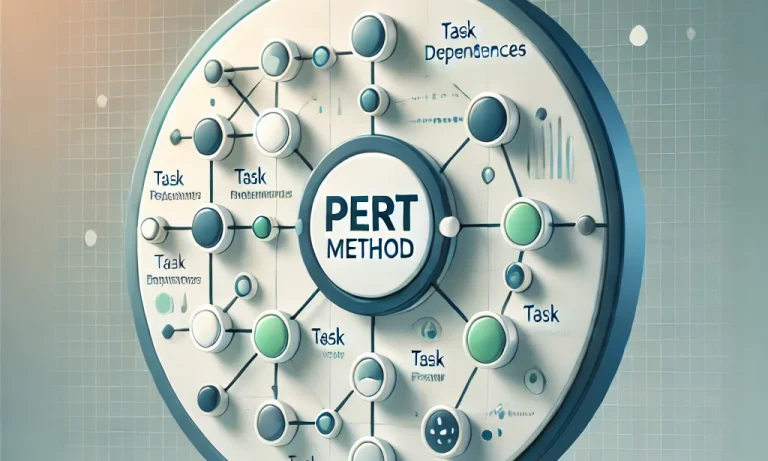The PERT Method is a project management tool that helps in organizing, planning, and scheduling the tasks involved in a project. The U.S. Navy developed it in the 1950s to manage complex defense projects, and private and public sector projects widely use it. This technique enables project managers to see the tasks, the dependency among them, and the time it will take to complete each of the tasks. The PERT Method is highly valuable in managing large-scale projects where the duration of a task is uncertain or unpredictable.
PERT Meaning
The PERT method involves a systematic approach to managing a project, which essentially involves the definition and analysis of the tasks that a project will entail. PERT was devised for handling uncertainty as well as variability in the time that might be taken in the completion of the set tasks. The PERT method involves statistical analysis combined with graphical representation, with which project managers can deduce the minimum project duration together with critical tasks that can delay the entire project.
Why PERT is Important for Project Management
The PERT method is very important for managing a project for several reasons. At the same time, because projects often have unpredictable timelines and results, PERT offers an ordered process for dealing with uncertainty. With this technique, it would allow the project manager to better plan, track, and control a project schedule.
Managing Uncertainty in Project Timelines
The key advantage of the PERT method is its capability to deal with uncertainty in estimating the time for each task. Traditional methods of project management assume that all tasks are completed in a fixed amount of time. However, in practice, the completion time for many tasks can vary based on weather conditions, resource availability, or unforeseen challenges.
Using three estimates—the optimistic, pessimistic, and most likely—the method will help project managers review both the best- and worst-case scenarios as well as the most probable outcome, so they can adjust their timelines and resource allocation proactively and minimize delays and budget overruns.
Enhancing Project Scheduling and Resource Allocation
PERT provides valuable insights into the critical path of a project. The critical path is the sequence of tasks that directly affects the overall duration of the project. With the identification of the critical path, the project manager can prioritize resources and efforts on the most important tasks, ensuring that the project stays on schedule.
The PERT method also contributes to resource allocation, especially when it emphasizes which tasks need more attention or resources. This approach enables managers to utilize other resources to reduce bottlenecks and boost the efficiency of the project.
Improved Communication and Coordination
In complex projects involving multi-team and multi-stakeholder environments, effective communication for project success is essential. PERT facilitates communication by delivering a visual representation of the project’s schedule. The network diagram developed in PERT remains a discussion tool for updating project progress, delay identification, and adjustment of the project. This transparency ensures that everyone is aligned with the project’s deliverables and timelines and improves coordination across team members.
What Is the PERT Method?
PERT is an abbreviation for Program Evaluation and Review Technique. PERT is a tool that helps in the organization and management of large projects. It is what determines the tasks and sub-tasks involved in the project, estimates the time taken to complete them, and the sequence of events to be undertaken in order to complete the project. It is especially useful when there is uncertainty about the duration of various tasks.
In PERT, tasks can be represented visually in a network diagram where the nodes show the tasks and the arrows represent how they are dependent on one another. Time estimates are usually given as three numbers: optimistic time (O), pessimistic time (P), and most likely time (M). With these estimates, the PERT method can determine the expected time required for each task and identify the critical path sequence of tasks that determine the total project duration.
How Does the PERT Method Work?
The basic steps of the PERT method involve:
- Define the tasks: Identify all the tasks needed to complete the project.
- Define dependencies: Determine the order in which you need to accomplish tasks.
- Estimate task durations: The project manager needs to estimate how long each task will take using the three-time estimates: optimistic, pessimistic, and most likely.
- Creating a network diagram: The tasks and their dependencies are then represented in a network diagram to represent the project schedule.
- Calculating the critical path: Using the time estimates, the method calculates the project’s critical path and the total project duration.
Through these steps, the PERT method helps project managers assess the feasibility and potential risks of a project and take corrective actions where necessary.

PERT Methods
Although useful alone, the PERT technique gains value in combination with other techniques. One of these is the Critical Path Method, and the other is the Time-Cost Trade-Off, Monte Carlo Simulation analysis. Each of them develops upon the PERT model with a more holistic picture of the duration, cost, and risks of the project.
Critical Path Method (CPM)
The Critical Path Method is part of the PERT method. PERT emphasizes the probabilistic nature of the durations of tasks, while CPM emphasizes the deterministic aspects of tasks that are necessary to complete the project. The critical path is the longest sequence of dependent tasks that determines the shortest possible duration of the project.
By knowing which path is the critical path, the project manager ensures that the key activities receive top priority. PERT and CPM combined offer an effective complementary method since they deal with uncertainty on the duration of some activities and have fixed dependencies between all the activities in a project.
Time-Cost Trade-Off
Time-Cost Trade-Off is another approach to PERT where it examines the interaction of time demands with corresponding costs. Many projects have cases where accelerating a job (crashing the schedule) is prone to cost increase through extra resources or overtime. On the other hand, a time extension might lower the costs, but it might cause a delay in the project.
The advantage of PERT is that the project manager can analyze all the trade-offs because it supplies several time estimates and calculates the total project duration under various scenarios. With analysis of expediting costs versus benefits, project managers can make informed decisions on resources and project timeline allocation.
Monte Carlo Simulation
The PERT method can use Monte Carlo simulation as an advanced statistical method to assess the risks and uncertainties of a project. This will run numerous simulations, depending on the different sets of input variables (e.g., task durations), and return a probability distribution of the completion times of the project. Adding Monte Carlo simulation makes the PERT method much more powerful in giving a clearer view of potential risks and the possibility of achieving project goals.
PERT Method FAQs
What is the main advantage of the PERT Method?
The primary advantage of the PERT method is its ability to handle uncertainty in project scheduling. It allows project managers to make more accurate predictions about project completion times by using three different time estimates for each task, which accounts for various uncertainties.
Can PERT Method be used for small projects?
Yes, the PERT method is flexible and one can apply it on both large and small projects. However, it is particularly useful for complex projects with uncertain task durations, where the visual network diagram and statistical analysis can help in planning and managing resources.
What is the Critical Path in PERT?
The critical path in PERT refers to the sequence of tasks that determines the total duration of the project. Any delay in tasks along the critical path will delay the entire project. Identifying the critical path helps project managers prioritize resources and monitor key tasks closely.
How does Monte Carlo Simulation enhance PERT?
Monte Carlo simulation enhances PERT by providing a probabilistic analysis of the project’s timeline. It simulates various possible outcomes based on different input parameters, helping project managers evaluate the likelihood of completing the project on time and under budget.
What is Time-Cost Trade-Off in the PERT Method?
The Time-Cost Trade-Off in PERT refers to the analysis of the relationship between task durations and costs. By speeding up tasks, you can shorten the overall project time, but it may incur additional costs. Conversely, extending the project timeline might reduce costs but risk delaying the project.


